A Classic Love Story
Enthusiasm is part of every activity at the Headwaters British Car Club. Someone suggests a drive through the Pine River Valley the next day with lunch at the Terra Nova Public House.
The love of British sports cars began in World War II, when Canadian and American servicemen and women discovered the joys of driving the twisting roads of Great Britain in the likes of MG Midgets and Morgans. Subsequent generations have now taken up the torch, and the enthusiasm for these classic vehicles continues unabated, especially among members of the Headwaters British Car Club.
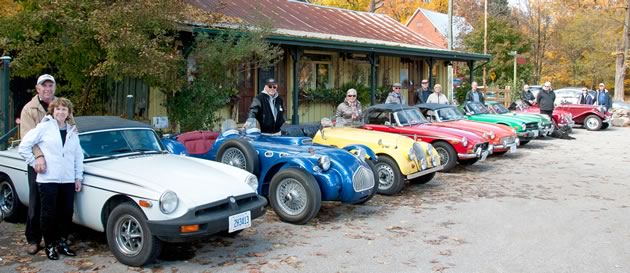
1977 MGB Roadster, Mike Davies, Diane Heavens; 1954 Allard, Alan Sands; 1967 Morgan Plus 4, Marlies Sands; and other members of HBCC at Mono Cliffs Inn. Photo by Pete Paterson.
Backed into their allotted spaces, as if preparing for a Le Mans start, the fleet owned by members of the Headwaters British Car Club recalls the golden age of British sports cars and the roots of sports car racing in Canada: the flowing bright blue Allard, dominant in early hill climbs and road races, MGs from the square T series, with spoke wheels and drop-down windscreens, the streamlined A and the preppy B.
Triumphs – low, lean and powerful – are here, too, along with the car many believe is the pinnacle of British sports car design, the Jaguar XKE, which has been called “a poem in steel.” When the E-type was introduced at the Geneva motor show in 1961, Enzo Ferrari, who founded the Ferrari automobile brand, said, “There is only one thing wrong with it … It doesn’t have a Ferrari badge.”
These are the cars many young people in the 1950s and ’60s drove, or wanted to. I’ll never forget the first time I drove an MGA, a white convertible with a red leather interior. It belonged to a neighbour across the street, and I could hardly breathe when he handed me the key and told me to go for a drive. I was 17 years old, king of the road, revelling in the green-eyed envy of my friends.
The club also includes Morgans, as well as a Mini, a Sunbeam Tiger, a Jensen and a 1929 Rolls Royce, not a sports car by any means, but an automobile that exudes a quiet dignity and regal demeanour, as if it’s presiding over the others. Whenever these classic cars gather, kids on bicycles and men in cheese-cutter hats stop to talk, and the drivers, basking in the reflected limelight of their vehicles, are keen to answer questions.

1970 Jaguar E-Type, Peter Pontsa; 1951 MGTD, Jean Louis Valade; 1975 MGB, Mary Valade; 1997 Jaguar XJR, Ken Stahl. Photo by Pete Paterson.
Enthusiasm is part of every activity at the Headwaters British Car Club. Someone suggests a drive through the Pine River Valley the next day with lunch at the Terra Nova Public House, and a dozen or more members pledge to show up. When the rendezvous is larger, involving more planning and other clubs, most members participate, gathering in parks and fields from Bronte to Collingwood.
At club meetings good-natured ribbing between the Triumph and MG camps can sidetrack proceedings. In May, the introduction of a new member prompted another member, obviously an MG owner, to shout this tongue-in-cheek question: “Do we really have room in the club for another Triumph?” To general laughter, someone else responded, “It’s okay. It’s a TR3.”
Club business is eventually taken care of and usually consists of a quick summary of forthcoming events, membership, club news and the like. Often a guest speaker is lined up.
Recently, for example, Rupert Lloyd Thomas, a motor racing historian from Toronto, was invited to trace the beginnings of sports car racing in Canada. It began with hill climbs at Rattlesnake Point near Milton and in the Hockley Valley in the 1950s and ’60s. Rupert’s presentation included home movies shot by one of the Hockley participants, and several club members recognized the racers and called out their names as their cars appeared on-screen.
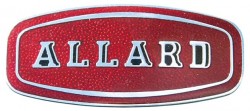 One club member, Alan Sands, actually drove in the 1962 Hockley hill climb and today owns two of the cars that competed: the 1955 Morgan he drove that day and a 1954 Cadillac Allard J2X. The Allards were shipped – without engines – to North America from a factory near London, England, and could be fitted with a DeSoto, a Lincoln flathead V12, a Chrysler or, as in this case, a Cadillac engine.
One club member, Alan Sands, actually drove in the 1962 Hockley hill climb and today owns two of the cars that competed: the 1955 Morgan he drove that day and a 1954 Cadillac Allard J2X. The Allards were shipped – without engines – to North America from a factory near London, England, and could be fitted with a DeSoto, a Lincoln flathead V12, a Chrysler or, as in this case, a Cadillac engine.
The HBCC was initiated in an Orangeville parking lot when Tom Hodgson and Norm Redpath happened to drive their cars to the same location. “I was at the garden centre,” said Tom. “Norm came in to buy plants. We got talking about our cars and car clubs and decided we should start one of our own. There were four of us at the first meeting and we had no idea how it would catch on.”
After a local newspaper published a feature article, a few more enthusiasts joined, and as word of mouth spread, the club ended up with many more members than expected. Often club members will leave notes on the windshields of sports cars they see parked in the Headwaters region or stop to invite the drivers to join. In four years the club has grown to include 92 members, the most recent addition being the TR3 owner.
The club, based in Orangeville, holds its winter meetings in the basement of the Royal Canadian Legion hall on John Street. Members drive in from Rosemont, Loretto, Tottenham, Caledon East and other communities within a half hour’s drive of town. And though Norm has moved to Collingwood, he remains very active. In fair weather, one member or another often invites everyone over for a barbecue, and the business part of the meeting take place as members munch on barbequed hot dogs, hamburgers and potluck salads.
The social activity of the Headwaters club sets it apart from many others and was one of the goals from the outset. “I have joined other clubs,” said Norm, “and they can tend to be ‘boys’ clubs’ and cliquey. We wanted ours to be a family-oriented social club, around cars. We do have our technical sessions, of course, but we wanted to keep both husbands and wives involved.”
Four positions on the club’s nine-member executive are filled by women – and many drive their own sports cars. Linda Guthrie, for example, drives a 1967 Morgan Plus 4, and Mary Valade has a 1975 MGB. “I loved this car from the moment I saw it,” said Mary. “It has big tires, a spoiler on the back and a cosmetic air intake, not original, of course – and it handles beautifully.”
Sandra Mason, who drives a 1978 MGB, believes the social aspect of the club is very important. “One reason I go out to events is to get to know new people,” she said. “We start with a shared experience with the cars, and friendships bloom in other ways from there.”
When In The Hills invited members of the club to a photo shoot on a sunny but cold autumn morning last year, we were expecting a few cars, but 20 arrived at Mono Centre. Many had open cockpits and no heat, except what the drivers could store beneath layers of hats, scarves and sweaters. Clearly, they are a hardy lot.
Though all club members love their cars, many have just one. Jean-Louis Valade, for instance, drives a 1951 MG TD to go with his wife’s souped-up ’75 B. And Ralph Philp is the original owner of a 1976 Triumph TR6. He bought it new and it’s still on the road – much to the surprise of some MG owners, no doubt. Norm and Hilary Redpath drive an orange 1967 MG Roadster. Hilary’s father spent many years restoring the car. When he finished in 2002, he gave it to his daughter. He’d had his fun and figured it was her turn.
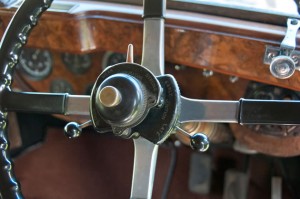
Throttle, ignition and carburetor controls on the steering column in 1929 Rolls Royce Model 20. Photo by Pete Paterson.
Bill Tully drove his 1953 MG TD to the photo shoot. He has a couple of other cars. “I had a ’78 MGB and bought another as a parts car. It turned out the parts car was better than the original, so I restored it.” Bill, who was an early member, keeps the club’s website up to date.
Others in the club have been at the workbench or under bonnets for many years. Ken Mason, husband of Sandra who drives the ’78 MGB, has several cars including a Triumph, a Jaguar and three or four Lotuses. “I was in the British car restoration business for 25 years, and although I shut down the business, I still have a few cars around.”
Despite his decision to retire, Ken can’t keep his hands out from under the hood. He still does some restoration, as well as repairs for a few club members, but on his own schedule.
Ken’s love of cars began very early. His dad used to supply trophies for some of the early races, and Ken would tag along. In high school he was a lot boy at the Sports Cars Unlimited dealership in Toronto. “Before school I’d go to the lot and wash all the cars, and after school they’d let me drive one to the licence bureau to get the plates they needed.”
He bought his first car from the dealership. That four-door MG Magnette, all wood and leather with a square clock above the windshield in the centre of the wood trim, cost $25. Today, Ken has thousands of parts and project cars he offers for sale on his website, kmrestorations.com.
“I went on a run with the club when they first started,” said Ken. “I wasn’t a member at the time, but I soon joined. They’re a fun bunch, although they are more MG-oriented than Triumph.” Oh, well.
Dorien Berteletti is another club member who owns several cars. In addition to the 1929 Rolls Royce mentioned earlier, he has a 1948 Bristol. “It’s the first model Bristol made and the only one in Canada,” he said. “I like to collect cars that are one of a kind or very rare.”
He also has a 1935 Indianapolis Grand Prix race car, a Hudson, which he still races at Watkins Glen, Lime Rock Park and in hill climbs in the United States. “I have a ’71 Alfa Romeo, one of only three in Canada, a smallmouth ’55 Triumph TR3 and others.”
(Dorien’s collection goes way beyond automobiles. In his dining room and sitting room are two rare motorcycles. Even his piano is unusual. It was made in Guelph and has four pedals. And in an aircrft hangar not far away sits a rare all-metal, low-wing Morane Saulnier from 1961.)
Alan Sands comes by his love of British racing cars from an entirely different angle: he used to race them. At one time, the CNE Grandstand entertainment included stock car races, and one year members of the British Empire Motor Club were invited to stage a classic car race during the intermission. The racers included quite a fleet: Triumphs, MGs, Austin Healeys, Morris Oxfords, Jaguars and an Allard.
Alan had joined the BEMC as a motorcycle rider but switched to cars when the MG TC came along. “The Allard blew past me in the race and I thought, I have to have that car. Unfortunately, the driver misjudged a turn and went into the wall.”
Alan next saw the Allard, restored and running well, at a race at Harewood Acres. Harewood, which had been a wartime training airfield, was converted into a racetrack by the BEMC, and Alan was a race marshal there. He saw the Allard again at the Hockley Valley hill climb and eventually bought it – and even raced it.
Today, Alan’s Allard is part of quite a collection. Between them, he and his wife Marlies own a pair of Mercedes 190 SLs, a couple of Jaguars, a 1967 Morgan Plus 4 and a ’55 Morgan, a 1954 MG TF, a Volkswagen Thing and a 1929 Morris Minor. “When I ordered the Morgan, in England, I found the Morris,” said Alan. “I bought it instead of wire wheels for the Morgan.” He paid less than $1,000 to buy and ship the car to Canada.
Now the Morris is in the ICU section of his workshop. The ICU is the only area that’s heated and it’s where he makes repairs. When body sections are too expensive or not readily available, Alan fabricates his own. The workshop includes a brake for bending metal, and he made an English wheel to create the curves.
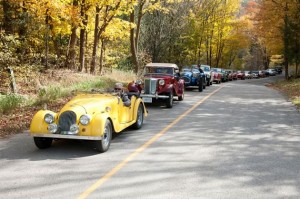
On the road again: 1967 Morgan Plus 4, owned by Marlies Sands; 1953 MG TD, Bill and Jane Tully; 1954 Allard J2X, Alan Sands; 1977 MGB Roadster, Mike Davies; 1961 MGA, Mike Davies; 1976 TR6, Ralph Philp; two red MGBs, Tom Hodgson and Mike Davies; 1975 MGB, Mary and Jean Louis Valade; 1970 Jaguar E-Type, Peter Pontsa; 1967 Morgan Plus 4, Linda Guthrie; 1948 MG TC, Malcolm Stanton; 1929 Rolls Royce Model 20, Dorien Berteletti. Photo by Pete Paterson.
Along with the cars, Alan and Marlies have a half dozen motorcycles, including two Harley-Davidsons they plan to ride to Alaska to celebrate Alan’s 80th birthday.
As it turns out, I have a somewhat tenuous connection to Alan’s Allard. When I grew up in Oakville, one of our neighbours was a man named Dave Pidgeon. He was the nephew of well-known Canadian-born actor Walter Pidgeon, and he drove around town in a blue Allard. My friends and I would stop and stare every time he passed by. Turns out Alan’s Allard is the same model as the one I admired in Oakville. In fact, it’s the same car! He bought it from Dave Pidgeon in 1962.
HBCC members will be busy this summer, often driving as a group to scheduled events. The last car in the procession is the “tail gunner,” transporting an emergency kit of tools and parts in case one of the cars breaks down. They do sometimes, but more often than not, the problem is easily fixed.
Many who pause to watch as this shiny and evocative fleet of British classics passes by will no doubt find themselves recalling their own dreams of setting aside everyday cares to savour the freedom of the open road. HBCC members are dedicated to keeping these dreams alive, and their dedication is a testament to the enduring popularity of these beautiful machines.
50 Years and Still Climbing

Alan Sands competed in the 1957 Hockley hill climb in his ’55 Morgan. As he climbed the hill, a BEMC club member snapped a photo of him sliding around a corner, spitting gravel from his rear wheels. Fifty-odd years later, Alan drove the same Morgan up the same hill, and his wife Marlies took a picture of him going around that same corner.
In early 1950, Don Albertson was out for a drive that took him through the Hockley Valley. Don, a member of the British Empire Motor Club, turned off the Hockley Road at the 3rd Line Mono and realized the winding road ahead would be ideal for a hill climb. The BEMC, which was formed in 1929 and incorporated in 1933, is the oldest motor club in North America. It already held regular hill climbs, in which cars race the clock from the bottom of a hill to the top, at Rattlesnake Point near Milton.
Club members also liked the location Don had found, and in the spring of 1953 the first Hockley Valley Hill Climb attracted nearly 40 entries, from Jaguars to MGs and even an Austin. Don entered and ran his Austin A40, the car he was driving when he discovered the hill. Alan Sands, now a member of the Headwaters British Car Club, went up twice, in two different cars, an MG TC and his Model T Ford. He holds the record for the slowest car up the hill. A Jaguar was fastest over the one-mile course, with a time of one minute, 14.22 seconds.
For ten years, from 1953 to 1962, the BEMC scheduled spring and fall hill climbs in Hockley. The event was cancelled a few times, mostly because of weather-related track conditions, but once because spectators had trampled the timing equipment.
Although many of the same cars competed year after year, new ones – Triumphs, Porsches, Corvettes, an Allard, a Sebring Sprite – joined and the times got faster. The fastest car in the race’s history is a hand-built vehicle that looked like a Formula 3 race car. It was powered by a Vincent Black Shadow motorcycle engine and completed the course in a cracking one minute, 1.64 seconds. That’s an average speed of a hair less than 100 km/h uphill and around corners on a dirt road!
The spring hill climb of 1962 was the last held in Hockley. That fall, the BEMC switched the race to the Mosport International Raceway and, with oxymoronic panache, called the event a “flat” hill climb, otherwise known as a sprint. The cars raced the opposite way around the course, from the Moss corner to the start/finish line.
On June 28, 2012, 50 years after that final hill climb, 20 cars assembled on the 3rd Line to mark the occasion. The Headwaters club organized the event, which included three vehicles – a 1949 MG TC, a 1954 Cadillac Allard J2X and Alan Sands’ 1955 Morgan – that had competed in the 1962 race.
Hockley Valley Hill Climb Video – 1957
Headwaters British Car Club Events
Members of the Headwaters British Car Club plan to take part in a variety of events this summer. These include:
- Sunday, July 21, Brits in the Park, Downtown Lindsay
- Saturday, August 10, Gathering of the Classics, Edenvale Aerodrome
- Sunday, August 11, Vintage Car Show and Shine, Dufferin County Museum
- Saturday, August 24, Copper Kettle Classics, Mill Street, Creemore
- Sunday, September 15, British Car Day, Bronte
For more information about these and other events, check the club’s website at www.headwatersbritishcarclub.org.

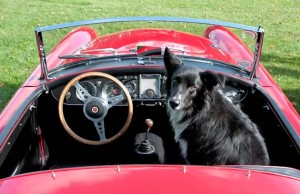

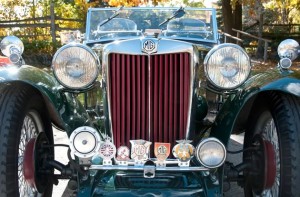
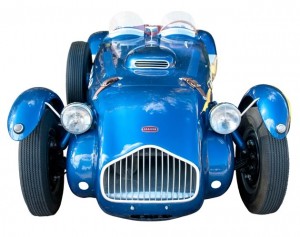






My name is Art Moseley and some of your members might remember me from the past as I joined BEMC sponsored by Jim Fergusson in 1948 when I worked part time at Scarborough Beach Garage, who sold Nash cars made in Toronto and those funny looking black English cars with the steering on the right side.
I was 17 years old at that time and just got my driving licence.
I too own a 1949 MG TC, which I purchased used from Scarborough Beach Garage in 1950 and own a number of other MG parts including a new frame.
My association with BEMC went far beyond what I ever expected, spending my life saving motor sport organizations, Canadian Warplane Heritage and a host of other clubs from going into receivership.
Arthur Le Bass Moseley from Orillia, Ontario on Mar 27, 2018 at 2:28 pm |